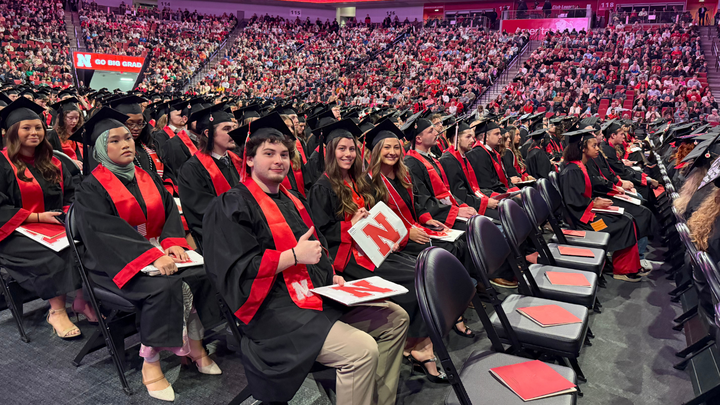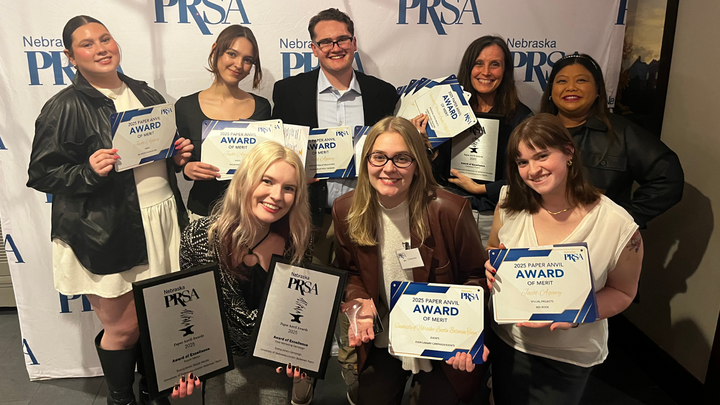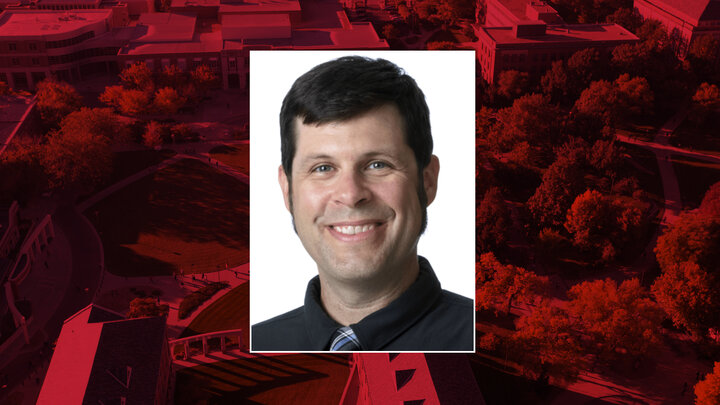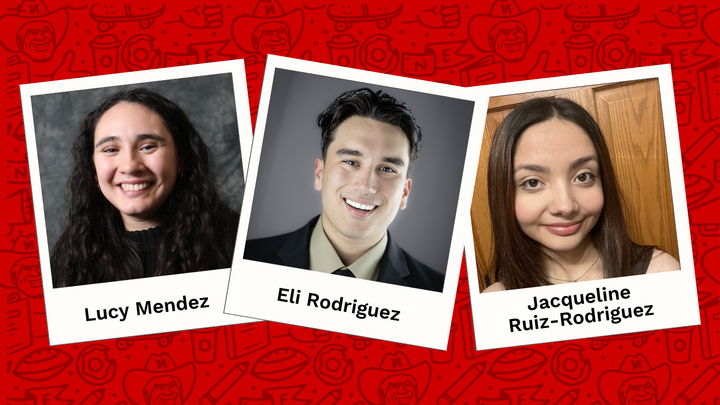In 2020-2021 the college focused on establishing a diverse community, creating an inclusive culture and advancing our collective knowledge of issues of diversity and inclusion.
The college made intentional efforts toward increasing the diversity of our faculty and student populations. To attract diverse candidates, the college established its own hiring webpage, participated in the ACEJMC Job Hub and posted faculty positions with organizations targeting journalism and mass communications professions and academics with organizations that focus on diverse populations. Advertisements were posted with:
-
Higher Ed Jobs
-
American Advertising Federation (National and Nebraska)
-
Public Relations Society of America (National and Nebraska)
-
American Marketing Association (National and Nebraska)
-
American Academy of Advertising
-
Nebraska Broadcasters Association
-
National Communications Association
-
Asian American Journalists Association
-
Association for Women in Communication
-
National Association of Black Journalists
-
National Association of Hispanic Journalists
-
Online News Association
-
Society for Professional Journalists
In 2020-2021, the college conducted seven faculty searches resulting in seven hires. In 2022-2021, the college conducted four faculty searches resulting in three hires.
The college also made efforts to increase the diversity of its student body. After a hiatus due to COVID-19, the college relaunched it's a la carte workshop program which provides faculty-led workshops to high school classes throughout Nebraska. In 2021-2022, the college conducted 44 workshops in 2021-2022. The college added four CoJMC Connections recruiting events during the year to provide prospective students increased opportunities to interact with the college in person or over Zoom. The college launched a partnership with the Boys and Girls Club of Lincoln to bring underrepresented students to the UNL campus to get a taste of the college experience. The college also hosted a Big Red Summer Camp in partnership with 4-H, to provide high school students with a week-long media experience at CoJMC.
Dean Shari Veil secured a grant from the Cooper Foundation to pilot a partnership with Bay High, a Lincoln magnet school focused on serving underrepresented students with interest in media. The partnership will establish an Experience Lab at Bay High in the fall of 2022, to provide students with the opportunity to gain hands-on experience and earn college credit in the CoJMC program and offer enhanced support to participating students to complete the UNL application process.
The college enhanced diversity and inclusion in the curriculum. During 2021-2022, a team of faculty reevaluated the college’s Global Eyewitness program, which provides students with the opportunity to travel internationally to tell stories about global issues. Due to COVID-19, the college relaunched the program domestically with a trip to the Pine Ridge Indian Reservation in May 2022, with plans to travel to Kenya in 2023. The college added a new requirement for all majors to complete JOMC 222 Social Justice, Human Rights and the Media before graduation. The college also hosted its first post-COVID study abroad course for sports media and communication students that traveled to Spain in May 2022.
The college took several steps to enhance support for struggling students and foster student success. The faculty passed a policy requiring the use of Canvas for course management and grading to create a consistent student experience as part of the college's updated policies and procedures. The college piloted a mid-term grade project aimed at identifying struggling students earlier in the semester and targeting them with academic outreach. The academic advising team increased targeted outreach to first-year students to ensure they meet with an academic adviser in both the fall and spring semesters to assess progress on their degree. The college’s scholarship committee also held a series of scholarship application workshops aimed at helping first-generation students understand the scholarship application process.
The college made efforts to tell more stories about underrepresented communities and enhance the visibility of diversity and inclusion within our community. The Nebraska News Service launched a new section in their online publication, “Diverse Voices,” dedicated to telling underrepresented stories. The first edition of Heartland Webzine focused on telling the stories of women entrepreneurs in Nebraska. A spring 2022 depth reporting course focused on reviewing past coverage by the Omaha World-Herald for racism and bias. A 12-part feature series, "Being Black in Lincoln," produced by depth reporting students, won the College Journalism Award at the Robert F. Kennedy Human Rights book and Journalism Awards on May 24, 2022.
To increase the visibility of issues of diversity and inclusion within the college, the college hosted alum Kevin Abourezk as the 2021 Multicultural Homecoming Distinguished Alumni in September 2021. In fall 2022, the college relaunched the CoJMC Book Club. Faculty and staff read “American Prison: A Reporter’s Undercover Journey into the Business of Punishment.” In partnership with Nebraska advertising agency, Bailey Lauerman, the college launched the Bailey Lauerman Design Diversity Challenge, which provides students the opportunity to design a mural that focuses on diversity for display in Andersen Hall. The inaugural winner, Ashleigh Kawaoka, had her mural installed on the third floor of Andersen Hall in May 2022.
|
Target |
Start (20-21) |
21-22 |
Goal (25-26) |
|
70% of faculty and staff will be enrolled in or have completed diversity, equity and inclusion training[1] |
70% |
82.61% |
70% |
|
90% of faculty will be utilizing Canvas for course management and grading[2] |
95.9% |
97.8% |
90% |
|
Increase enrollment of students from underrepresented ethnic/racial groups by 7%[3] |
217 |
217 |
239 |
|
Increase enrollment of international students by 10%[4] |
41 |
29 |
45 |
|
Increase the number of underrepresented and first-generation students participating in student involvement opportunities by 5% over a base rate established in the first year[5] |
- |
- |
- |
|
Decrease the number of underrepresented reporting concerns as part of the Husker Power Survey by 10%[6] |
37 |
59 |
33 |
|
Decrease the number of first-generation students reporting concerns as part of the Husker Power Survey by 10%[7] |
33 |
58 |
30 |
|
Increase the number of first-generation and underrepresented students who apply to the college by 10%[8] |
125 |
136 |
138 |
|
Increase the number of underrepresented faculty and staff candidates in short lists by 10%[9] |
20.8% |
8.3% |
22.8% |
[1] Percent of full-time faculty and staff who were currently certified for search committee service during the fiscal year.
[2] Data is drawn from the UNL Undergraduate Analytics Canvas Course Metric Report.
[3] Data drawn from the IEA Data Index Enrollment Table 100
[4] Data drawn from the IEA Factbook
[5] The Senior Exit Survey records student involvement but does not record race/ethnicity or first-generation status. The college is evaluating changes to the survey to better capture this data.
[6] Data is calculated from the UNL Surveys Fourth Week Survey Results report for the fall semester. It is the total number of concerns expressed by non-white students.
[7] Data is calculated from the UNL Surveys Fourth Week Survey Results report for the fall semester. It the total number of concerns expressed by first-generation students.
[8] Data is drawn from Academic Services and Enrollment Management Special Populations Funnel Report
[9] Data is provided by the Office of Institutional Equity and Compliance and is shown as a proportion of the shortlist as the size of candidate pools varies widely based on the number of searches conducted.
Review of the targets
Our faculty overwhelmingly use Canvas for course management and grading, and we did see a moderate increase in 2021-2022. Since the faculty passed a new policy requiring the use of Canvas, the college may want to reevaluate this target.
The number of students from underrepresented groups remained flat in 2021-2022. However, due to large graduating classes, the overall student enrollment in the college declined from 1,055 to 961. Therefore, the proportion of enrollment from underrepresented groups increased from 20.5% to 22.6%.
The college saw a decline in international student enrollment. This mirrors the overall trend at the university where international enrollment has been declining since 2018. COVID-19 had an amplifying impact on declines in international enrollment due to new restrictions placed upon international travel.
The number of concerns expressed by both underrepresented and first-generation students increased in 2021-2022. However, the overall number of respondents to the survey also increased due to increased efforts at both the campus and college levels to raise awareness and participation in the survey. In 2020, 107 students completed the survey, with 30.8% of concerns expressed by first-generation students and 34.5% expressed by underrepresented students. In 2021, 205 students completed the survey, with 28.9% of concerns reported by first-generation students and 29% expressed by underrepresented students.
The proportion of underrepresented candidates in faculty short lists fell dramatically in 2021-2022. Examining the gender and race/ethnicity of candidates throughout the hiring funnel paints a clearer picture. As we move through the funnel our pools become more male and less racially diverse.
A review of our applicant funnels indicates that we could seek to improve efforts to attract female candidates. Additionally, while the college is attracting applicants that are racially or ethnically diverse, we may not be attracting qualified diverse candidates or may be making decisions during the hiring process that present barriers to diverse applicants being selected for shortlists.



